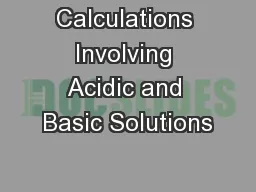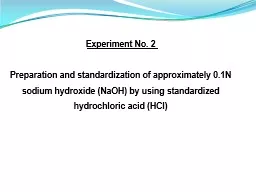PPT-Calculations involving solution preparation and Dilutions
Author : tatiana-dople | Published Date : 2018-03-23
Solutions Expressed as percent The term percent is Greek for per 100 When concentration is expressed in terms of percent the numerator is the amount of solute
Presentation Embed Code
Download Presentation
Download Presentation The PPT/PDF document "Calculations involving solution preparat..." is the property of its rightful owner. Permission is granted to download and print the materials on this website for personal, non-commercial use only, and to display it on your personal computer provided you do not modify the materials and that you retain all copyright notices contained in the materials. By downloading content from our website, you accept the terms of this agreement.
Calculations involving solution preparation and Dilutions: Transcript
Download Rules Of Document
"Calculations involving solution preparation and Dilutions"The content belongs to its owner. You may download and print it for personal use, without modification, and keep all copyright notices. By downloading, you agree to these terms.
Related Documents














